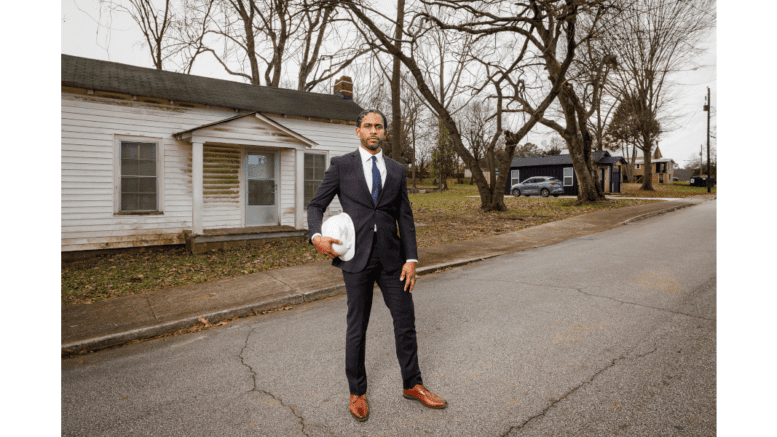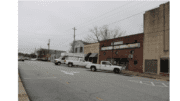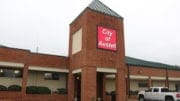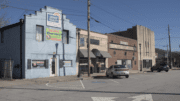[All photos and renderings provided by Derek Caffe]
Last Friday, the Courier interviewed Derek Caffe, one of the founders of Create Austell. Create Austell states on its Facebook Page that it is “a social group and movement designed to help influence the future of Austell, GA with respect to Housing/ Zoning, Sustainability, Mobility, Arts & Culture.”
Caffe recently got approval to build in downtown Austell what might be the first duplex approved in the city in 50 years.
During the interview, he spoke about how he came to downtown Austell, how he got into the real estate and development business, what his vision is for the city, and how the duplex project developed.
He said he first came to the Austell area when he purchased a duplex in Clarkdale Mill Village as an investment project.
“This story could have easily been about Jonesboro, which is where I had my first house under contract,” he said. “And what happened was the appraisal came back $50,000 lower than the purchase price.”
Caffe said that he worked at the post office when he first decided to renovate and sell houses. He said of the post office job, “I learned why there was a term ‘going postal’ in the post office.”
“And so for my personal health, I had to get out of the post office; I’m talking about just chest pains and everything from stress,” he said.
“I was looking for multifamily housing because I wanted to live in one side and rent out the other,” he said. “That was my goal.”
“I found this duplex here in the Clarkdale/Austell area,” Caffe said. “And I remember telling my now wife, then girlfriend, ‘it’s not a home run, but it gets me on base’, because at that point, I’m just renting an apartment.'”
After buying the Clarksdale house, he bought a second duplex on Perkerson Mill Road near Austell, in an area that has now been incorporated into the City of Mableton.
He said his goal was to buy five duplexes and then quit the post office, but at that point, his stress level was so high he quit after buying two.
Caffe described his path from becoming a renovator to a real estate agent and finally to a developer.
“I had two rental properties. The second rental property needed a full gut,” he said. “It was just horrible, with animal remains inside and a roach infestation.”
“I bought it in February of 2016 and quit my job in March of 2016,” he said. “So I knew I needed to get to work during my time off.”
“I spent it starting to learn about construction. I enrolled in “YouTube University” and started watching videos on how to install cabinets, how to install tile, and various construction techniques.
“I spent hours on this because I had nothing else to do at that point, and I had two rental properties.
“It took me just over a year to complete the renovation. I bought it in February 2016, and someone moved into one unit in September 2016, with the other unit being finished around February or March of 2017.
“I absolutely loved the entire construction process, renovating both units and making them look brand new. It was all cosmetic work, the kind of pretty stuff, not heavy-duty electrical or plumbing work. I had to add a dishwasher, and it was my first time working with electricians and plumbers.
“That’s where I really learned the ropes after I got out.
“Once the project was finished, the agent who helped me buy the second house suggested that I become a real estate agent.
“He had been telling me this for a while, but I had been resistant, wanting to focus on investing. What convinced me was when he mentioned that he was making 15 to $20,000 a month. That sounded crazy to me at the time, and I thought he was exaggerating. But when he showed me his commission checks, I realized he was not.
“He even sent me a Groupon coupon for the real estate agent class. I took the class, passed it, and went through different brokers before ultimately ending up at the same brokerage as him.
“He guided me on what to do, and in my first year as an agent, I sold 13 houses. It was a significant increase in income compared to what I had before. With the extra funds, I started getting more involved in the construction side of things and even built an accessory dwelling unit in the back of my first duplex. That’s how I got started on this path.”
The Courier asked how he developed the ideas that led to cofounding Create Austell.
After buying the first two properties, he said, he realized they were close to downtown Austell and connected to downtown Powder Springs by Austell Powder Springs Road.
“I remember driving around and thinking to myself like, wow, if both of these downtowns start to develop and build themselves into something, imagine how close we’d be to all of these different amenities,” Caffe said.
Caffe said that, at the same time, he had read about various projects in trade publications and followed articles about the Atlanta Beltline in the Atlanta Business Chronicle.
“And so I’m watching people go up and down Austell Powder Springs Road and I’m like, ‘What if you had a beltline that connected these two downtowns?'”
He said the plan didn’t come to fruition until he met public transportation advocate Matt Stigall of A Better Cobb during a public meeting organized to get input on a proposed trail connecting Austell to Powder Springs along Austell Powder Springs Road.
They talked about the potential for Austell, and soon thereafter, Create Austell was formed.
Vision for Austell, and how the duplex fits into the picture

Caffe talked about his duplex project.
“If you look through Austell’s history, this will probably have been the first upzoning and new construction of multifamily in the city, probably in several decades,” he said. “I’d estimate around 40 to 50 years because, if you look back, the last kind of duplexes that I can see were constructed in the 60s.”
“So it has been a while since anybody has had success in making this happen,” Caffe said.
“Part of the reason I believe it was able to happen was because I have been in the city since 2015,” he said. “I started to get very involved in local politics. I began showing up to city council meetings and Planning and Zoning meetings, trying to understand how things worked because I didn’t come from a real estate background at all.”
“I’m just a guy who read a book called ‘Rich Dad Poor Dad’ by Robert Kiyosaki about a decade ago and thought, ‘Okay, I want to get out of the rat race. Real estate is my venue.’ But I had no clue what that really meant. It was just an inspiration.”
“So, for me, the best way to figure it out was to see how the process worked with the government because I knew it was related to the government,” he said. “I started showing up at these council meetings and, on my own, reading tons of books about urban planning, like ‘Happy City’ and ‘Creative Communities.'”
“I also did some self-education, listened to Strong Towns and their message about building more walkable and economically viable urban environments,” Caffe said. “Learning to speak the language became my thing, and because of that, I started getting invited to different stakeholder meetings.”
“When our 2017 comprehensive plan came up, I was invited to that meeting as a private citizen to give advice on the future of our city,” he said. “When our 2022 plan came up, I was also part of that.”
“When our LCI study came up, I was a part of that too, and even when the Austell Powder Springs Road trail came up, I was a part of that process.”
“Due to my involvement, I was able to contribute my vision and the knowledge I had gained to these programs,” he said “When discussing future growth, and because these documents are supposed to govern the way things are built, I had the ability to advocate for some of the changes I wanted to see in our city.”
“So, that’s how I found myself on these different commissions, which allowed me to be in a position to influence the direction of the city,” he said.
“Over this time period, since 2015, I’ve acquired several other properties in the downtown area,” Caffe said.
Recognizing the potential of downtown Austell, he acquired two properties across from Volkstuin from former Governor Roy Barnes in 2019 and began searching for other properties to add to his portfolio.
“I was successful in acquiring one side of a block of Carol Way in downtown Austell,” Caffe said. “My vision for this area was to create a walkable, mixed-use section of the community, serving as an example of new urbanism within the city.”
“This endeavor marked my second step in real estate development. My first step involved a unique approach: instead of demolishing and building a larger structure, I decided to renovate a small 556-square-foot house on the property,” he said. “This decision was unconventional, as most advised me to build a larger, more conventional house.”
“However, my goal was to showcase different types of ‘missing middle’ housing that didn’t exist on one street at a high degree of quality,” he said.
“Missing middle” is a term used by urban designers and planners for duplexes, fourplexes, cottage courts, and courtyard buildings, all rendered illegal by most zoning codes since the 1940s. They rest in the middle of single-family detached homes and denser multi-family housing types.
“I believed this was essential to dispelling misconceptions about small houses, such as those associated with tiny homes,” he said. “Renovating the existing house to a high standard, with brand-new electrical, roofing, framing, and plumbing, caught the city’s attention.”
“They saw the potential of this approach, which had initially faced skepticism,” he said.
Caffe said the success of that project helped change the perception of housing options, including the possibility of cottage courts.
“It became clear to me that visualization played a crucial role in convincing people of innovative housing concepts,” he said. “Providing a high-quality example could help people overcome their reservations.”
“Building on this success, I continued my efforts on the same street. Recognizing the need for more density and rooftops in the downtown area, I decided to propose a duplex on a lot that originally housed a single-family dwelling,” Caffee said. “Instead of a traditional duplex, I designed one that didn’t resemble the conventional notion of a duplex and could serve as multi-generational housing.”
“Multi-generational housing is a growing need that often goes unaddressed,” he said. “This unique duplex comprised a two-story section with either four bedrooms and three baths or three bedrooms and two baths, and an adjoining two-bedroom, two-bath unit.”
“The design aimed to accommodate various demographic groups, from small families to couples wanting rental income or seniors who preferred a single-story dwelling,” he said.
To accommodate residents who, because of age or disability, could not handle stairs, the design included a no-step entry.
“In my proposal to the city, I emphasized the financial benefits of duplexes, which are taxed at a higher rate than single-family homes, thus generating more tax revenue,” he said. “Additionally, I highlighted the innovative and progressive nature of the project, showcasing the city’s willingness to embrace new concepts.”
Caffe also enlisted the support of the surrounding neighbors. Because empty houses had been on the lots he had acquired for years, and because he lived in the neighborhood and had a track record of quality work, there was no opposition to the duplex.
Approval for the duplex passed the Austell City Council 6-0.




